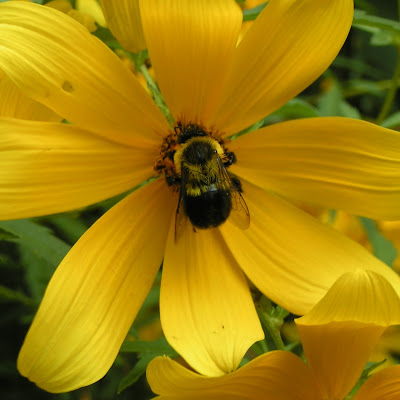 |
| A swarm cell. |
I checked the two hives yesterday and made some interesting observations. First, the queen was actually in the new, smaller hive. I had initially assumed that she was still in the older hive because this would be statistically more likely (i.e. I had transferred only a few brood combs to the new hive and the odds that she would have been on one of those combs during the transfer were less than the odds she was on the untouched combs) and because the bees in the new hive were behaving so defensively (which can be a sign that they lack a queen). However, during my inspection of the older hive, I encountered a capped emergency queen cell on a comb near the front of the hive. When I encountered this, I immediately opened up the smaller new hive and, sure enough, there she was. I then closed up the new hive and resumed inspection of the older hive.
It was at this point that I made my second observation: loads of capped swarms cells! To explain why this is so significant, I first need to explain the difference between "emergency queen cells" and "swarm cells." When a hive is strong with a large population and plenty of resources, the bees may decide to swarm or split into two hives. Of course, when you have two hives you need two queens, so, prior to splitting, the bees begin to grow a new queen in what is called a "swarm cell" (actually they will grow several potential queens that will duke it out when they hatch). Just as worker bees are raised from eggs in the familiar hexagonal cells we see in wax comb, a queen bee is raised in a much larger specially built wax cell that is called a "queen cell." If the hive is planning to raise a new queen (e.g. when they are planning to swarm), these cells will typically be built along the side and bottom edges of the comb.
 |
| "Swarm Cells" - A swarm cell starts out as a small shallow up-side-down wax cup that the
worker bees build along the edges of the comb. Then the queen lays an
egg in the cup and, as the egg hatches and the larva grows, the sides of
the cup are expanded downward until the cell is capped with wax for the
last phase of development. At this point, the old queen flies off with a portion of the bees, finds a new hive location, and rebuilds. |
 |
"Emergency queen cells" are fewer in number and can be found sticking out of the center of a patch of brood comb.
|
When the queen dies unexpectedly, the worker bees will attempt to create a new queen by raising an normal worker bee egg that the now dead queen laid into a queen. In this case, the cell walls surrounding the egg will be destroyed and rebuilt into a larger cell that can accommodate the developing queen.


As you may recall from my previous posts, I had begun to suspect that the bees in my single large hive might try swarming in the near future. You may also recall that, although I did not see any hard evidence, such as swarm cells, I had decided to pre-empt the possibility of a swarm by splitting the hive into two hives. Well, now that I've found between 15 and 20 swarm cells in the older hive, it appears that I have confirmation and wasn't entirely crazy.
With this confirmation comes the new possibility of a "secondary swarm." I've read that, sometimes, when a hive is very large, the first new queen to hatch will also decide to leave the hive or swarm with a portion of the hive's workers.
Consequently, in an attempt to mitigate this concern, I've spent the last day building two small bate-hives designed to attract swarming bees.
Here are some of the flowers that can currently be found blooming in my area.
 |
| Bidens sp. flower. |
 |
| More Bidens sp. flowers. |
 |
| Curcurbita moschata male flower. |
 |
| Curcurbita moschata fruit. |
 |
| Ageratina altissima flowers. |
 |
| Rubeckia hirta flower. |
 |
| Eupatorium perfoliatum flower. |

















.JPG)













